The development of lithium-ion battery technology has been fundamental to the growth and popularization of the e-bike industry. Lighter, longer-lasting, and higher-capacity batteries have made e-bikes more enjoyable to own and more versatile in their capabilities.
We’ve put together this comprehensive guide to help you understand the basics of e-bike batteries, how each specification impacts performance, and how to care for and maintain your battery.
You’ll learn the different terminology, designs, and components of batteries. In addition, we explore the varying weights and capacities, mounting positions, and the potential dangers associated with owning a battery.
With this knowledge, you will be better equipped to choose the right e-bike battery for your needs, prolong its lifespan, and ensure safe operation.
E-Bike Battery Specifications Explained
Before diving into the basics of electric bike battery technology, you should understand what we’re referring to when we discuss the specifications.
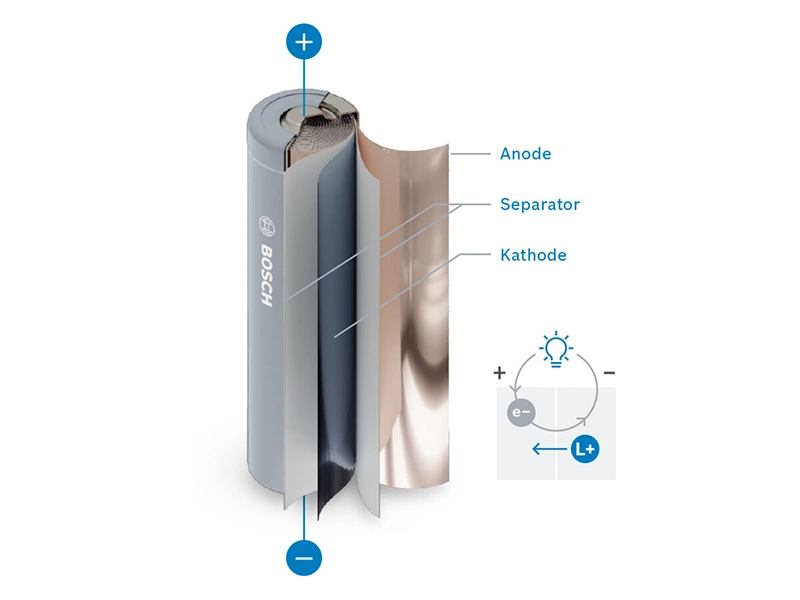
An illustration of the inner workings of a Li-ion battery. (Source: www.bosch-ebike.com)
Here are the most important ones:
- Voltage (V)
Voltage measures the force of the flow of electricity from the battery to the motor. Think of it as the electrical pressure that pushes an electrical charge through a circuit. The higher the voltage of an e-bike battery, the more power it can provide to the motor, typically allowing an e-bike to reach higher max speeds.
Standard ratings for e-bike systems are 36V, 48V, and 52V. Most 250W motors pair with 36V batteries and controllers. All EU and UK-legal e-bikes are limited to 250W, so 36V systems like those from Bosch, Shimano, and Brose are the most common. In contrast, most 750W e-bikes from US-based brands use 48V systems.
- Amps (A)
‘Amps,’ named after French mathematician André-Marie Ampère, are the unit of measurement of the flow of electric current through a circuit.
Amps measure the amount of energy being drawn from the bike’s battery at a given moment. The more Amps being drawn, the more power the motor can produce. E-bike manufacturers typically provide an Amp-hour rating instead of an Amp rating alone.
- Amp-Hours (Ah)
Amp-hours measure how many Amps the battery can deliver over an hour period. For example, a 13 Ah battery can provide 13 Amps for one hour or 6.5 Amps for two hours.
While this is useful information for determining range, it is best taken in the context of the motor’s voltage. Doing so gives a measurement of the total energy capacity of a battery (Watt-hours).
- Watt-Hours (Wh)
As mentioned, Watt-hours is a measure of the battery’s total energy capacity. This number is calculated by multiplying voltage and Amp-hours (V×Ah=Wh). For example:
36V x 7 Ah = 252 Wh
or
48V x 14 Ah = 672 Wh
This measurement is more informative than the Ah rating alone, as it accounts for the force and volume of the flow of electrical current. However, it is just a small part of determining electric bike range. A motor’s efficiency, total payload weight, weather conditions, elevation gain, and many other factors determine the range, which we will cover in an upcoming section.
- Watts (W)
Watts is a measurement of the power being produced by the motor. Manufacturers typically provide two ‘W’ ratings; continuous (nominal) and peak. The continuous power output is the max output a motor can sustain for a given period of time. The peak power is the max it can achieve in an instant or for a short burst.
For example, all e-bikes with a Bosch motor are rated for 250W of continuous power on the highest setting. However, the Performance Line CX motor will momentarily provide 600W of power. Manufacturers don’t measure peak power in a standardized way, so not all motors with 600W peak power will perform the same.
- Battery Cell and Battery Pack:
Electric bike batteries comprise individual energy-containing cells, which combine to create a battery pack with the desired characteristics. Each battery cell has a max of 3.7V and a specific Ah capacity.
Manufacturers will connect the cells in a specific configuration and add a battery management system (BMS) that controls the charging process.
Electric Bike Batteries Dissected: The Basics
Now that we understand some of the terminology used to describe e-bike systems, we will cover more of the characteristics of electric bike batteries.
What Are Modern E-Bike Batteries Made Of?
All modern e-bike batteries use lithium-ion technology. This technology replaced lead-acid batteries, which were cheaper but heavier, less efficient, and less durable. Manufacturers use different combinations of precious metals to create batteries, each with slightly different properties.
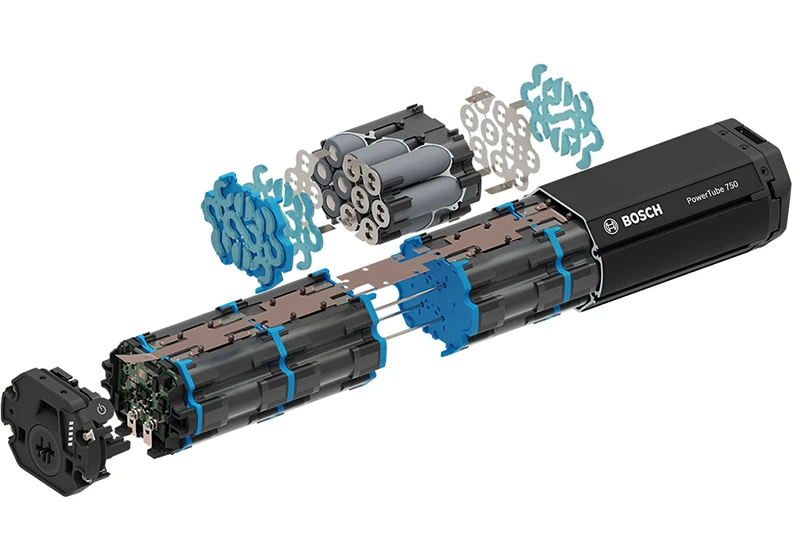
An exploded view of a Li-ion ebike battery showing multiple individual cells. (Source: www.bosch-ebike.com)
Lithium-ion batteries comprise individual cells to form the battery pack enclosed in a protective plastic shell alongside a battery management system (BMS). The BMS monitors the charge level of the cells and manages the charging process to avoid overcharging and help prevent overheating, which, as we explain later, are detrimental to battery health and potentially dangerous.
Other components of a battery for an electric bike include wiring, connectors, and, often, charge level indicator lights. Some batteries have USB ports for charging devices while riding.
E-Bike Controllers and BMS Explained
An electric bike controller is a mini computer that acts as the brain of the e-bike system. It receives signals from the sensors, display, throttle, motor, and battery and communicates with the battery to release electricity to the motor.
Controllers, batteries, and motors must be Voltage-matched to ensure safe function. Controllers also determine the peak power output a motor can achieve. Find the peak power output by multiplying the controller’s Voltage and Amp ratings. For example, a 48V, 25A unit will allow the motor to max out at 1200W.
Another fundamental yet lesser-discussed e-bike technology is the battery management system. This is an electronic system in lithium-ion batteries that monitors the state, including temperature, Voltage, and charge level. In addition, it balances the charge of the individual cells and generally controls the charging and discharging process. A BMS can also provide details about the battery lifespan.
These systems are fundamental to prolonging battery lifespan and reducing the likelihood of overheating and fires. A lithium-ion battery without a BMS would quickly overheat when left plugged in, likely resulting in a fire.
Battery Position
Where and how the battery is mounted onto or integrated into an e-bike frame impacts how easy it is to access, its durability, and how the bike handles (due to effects on the center of gravity and weight distribution).

Common ebike battery mounting positions: 1) Rear rack; 2) Frame; 3) Semi-integrated; 4) Fully-integrated.
- Rack Mounted – One of the most common battery mounting positions in the early years of e-bikes was under the rear pannier rack, making for easy access. This is a straightforward approach for frame design, resulting in a cheaper product overall. However, the battery is more exposed to the elements, and it limits the use of certain pannier bags. In addition, it puts a lot of extra weight over the rear tire and raises the center of gravity, negatively impacting handling.
- Frame-Mounted – Mounting batteries on the frame was the other typical method in early e-bike designs. The battery goes directly on the tubing, which is still easy to access and results in more favorable handling. However, it meant being exposed to the elements and vulnerable in the event of an accident.
- Semi-Integrated – The first attempts at integration of batteries into the frame were partial integration. Semi-integration is still used for e-bikes with high-capacity batteries. This method protects the battery more and improves security and durability compared to frame-mounted.
- Integrated – The newest and most common battery mounting location is in the frame’s downtube. Smaller battery sizes have made this easier. This approach is the most protective and has the best ride characteristics. However, some integrated batteries aren’t removable, which makes charging inconvenient.
Average Battery Weight and Capacity
Batteries for electric bikes are quite varied. Low-cost units can be bulky and slightly heavier (Reention), while premium manufacturers like Fazua, Mahle, Bosch, and Shimano manage to squeeze more energy into smaller units.
In general, the larger the capacity, the bigger it is and the higher the weight of the battery. Therefore, a trade-off for increasing range is adding weight and size.
- Bosch 500Wh PowerTube: 6.6lb
- Shimano 504Wh: 6.4lb
- Bafang 504Wh: 6.4lb
- Reention 504Wh: 7.05lb
How to Calculate the Range of an Electric Bike?
Calculating electric bike range is not an exact science. It’s impossible to account for all the factors contributing to energy usage. However, you can make an estimate by considering the most important factors, such as weight, elevation gain, wind, temperature, average speed, and throttle use.
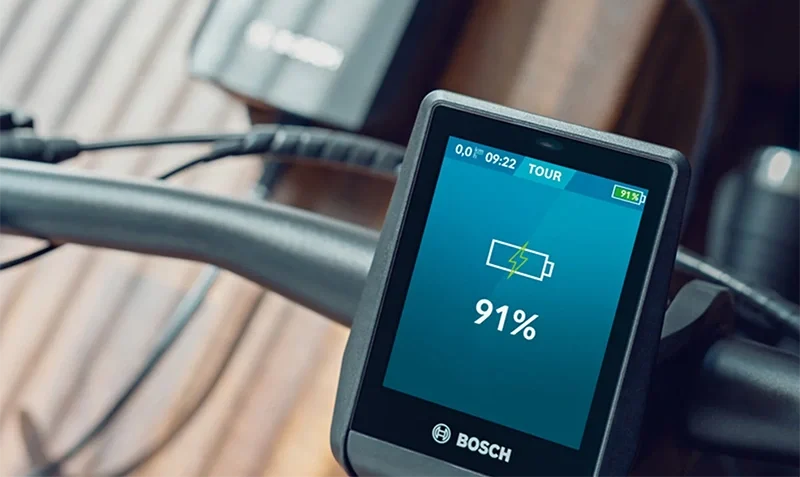
Ebike battery range can never be 100% accurately calculated, but it can be closely estimated. (Source: www.bosch-ebike.com)
Firstly, you must know the Watt-hour rating (Wh). If you don’t have this number, multiply the battery’s Voltage by the Amp-hour rating to find it. These numbers should be available on the product page of the manufacturer’s website. For example: 48V × 14 Ah = 672 Wh
Next, determine how many Watt-hours your bike uses per mile. A rough usage guess for a hub-drive commuter-style electric bike on moderate pedal assist settings with an average rider weight is 20 Whs per mile or 33.6 miles per charge.
672 Wh ÷ 20 Wh/mi = 33.6 miles range
The more challenging the conditions (higher weight, more elevation, higher average speed, or heavy throttle use), the higher the Wh/mile number should be. Including these in the calculation can give you a more accurate picture of the range in certain situations.
For example, a heavy rider using high pedal assistance levels riding on hilly terrain with moderate throttle use may increase the Wh/mile rating to 32, resulting in 21 miles per charge.
672 Wh ÷ 32 Wh/mi = 21 miles range
While the results will never be 100% accurate, you’ll get a decent estimate of the range to expect. The best way to get an accurate range assessment is to ride your e-bike in typical conditions with a full charge and check the ride odometer to see what it says when the battery dies.
Battery Lifespan: How Long Do E-Bike Batteries Last?
Estimating the average lifespan of an e-bike battery is complicated because of the variation in battery quality, usage, and care.

With proper care, electric bike batteries can last for years and tens of thousands of miles. (Source: bike.shimano.com)
The average lifespan is two to five years or 10,000 to 30,000 miles. However, these figures aren’t relevant on an individual level, as you can maximize the lifespan by doing the right things.
To determine your battery’s lifespan, you must know its ‘charge cycle’ rating. Modern lithium-ion batteries typically have a rating of between 500 and 1000 cycles.
A single cycle refers to a full charge from 0% to 100% or two charges from 50% to 100%, and so forth. Notably, when your battery reaches its rated number of cycles, it should have around 60 or 70% of its initial capacity.
- Detailed guide: How Long Does an E-Bike Battery Last?
For instance, Bosch indicates that its batteries for electric bikes “should have 60 to 70% of the original capacity” after reaching the rated number of charge cycles.
By following the appropriate care and usage guidelines (outlined below), you can get the most out of your battery and save money on replacements in the long term.
Sample Battery Lifespan Calculation
Let’s assume your e-bike battery is rated for 500 cycles. For the first 250 cycles, each full charge gives you an average of 50 miles, and for the subsequent 250 cycles, it gives you 40 miles. This would total 22,500 miles after 500 cycles (500*45).
If your daily riding distance is 25 miles, you will cover approximately 9,125 miles in a year (25*365). After around 2.46 years of this average distance, you’d complete 500 cycles (22,500/9,125). During this time, your battery’s range-per-cycle could drop to 30 or 35 miles and continue decreasing until it fails.
If a declining range is acceptable to you, the battery could last an additional two or three years (totaling around 1,500 cycles) before it stops working.
How to Prolong the Life of Your E-Bike Battery
Multiple factors impact an electric bike battery’s lifespan, such as how you charge it, where you store it, and how you ride your e-bike. Here are six tips to prolong the life of electric bike batteries:
- Avoid fully charging and discharging your battery. Removing the battery from charging before it hits 100% and not letting it drop below 20% can help extend the battery life. Shorter charge cycles (discharging the battery by 25 to 75%) are ideal.
- Don’t overcharge your battery. Leaving electric bike batteries plugged in after reaching 100% can speed up degradation. It’s recommended to set a reminder to unplug the battery before it reaches 100%.
- Keep the battery at roughly half charge (30-70%) in a temperature-stable environment if storing it for more than a couple of weeks. Also, recharge the battery slightly every few months to maintain the charge close to the manufacturer’s recommendations. Store your battery in a cool, dry place.
- Avoid extreme heat. High temperatures can shorten the battery’s life. Operating the e-bike in very hot conditions can cut the battery capacity in half. The optimum temperature for maximum capacity is around 68°F.
- Use the original charger only. Using an incorrect or cheap replacement charger can cause irreparable damage to the battery. If the original charger breaks, buy a replacement from the e-bike manufacturer.
- Keep electric bike batteries away from water. Store the battery in a dry place and avoid moist or humid environments. While batteries for electric bikes are generally water-resistant, they should never be submerged in water or washed with a pressure hose.
- Use high pedal assistance more conservatively. For example, a rider using ‘Eco’ mode could achieve a 75-mile range per charge, while a rider using ‘Turbo’ mode might only get 30 or 35 miles.
Dangers of E-Bike Batteries
Lithium-ion battery technology makes it possible to store lots of energy in a small space. However, there are risks associated with this design, so owning a battery for an electric bike requires care.
The energy stored in these batteries is highly flammable and unstable when damaged, potentially resulting in a fire. Ebike battery fires are extremely aggressive when they occur, spreading fast and igniting anything else flammable in the surrounding area.
E-bike battery fires are occurring with increased frequency in densely populated areas where e-mobility devices are commonly used, and many result in death or injury.
To avoid electric bike battery fires, follow these best practices:
- Charge the battery only when you’re present
- Only use the charger that comes with your e-bike or one issued by the manufacturer/e-bike brand
- Charge the battery away from flammable materials, preferably outside or in a fireproof container
- Only use batteries with UL Certification
- Assess your battery for damage after a crash
- Don’t use off-brand replacement batteries or chargers
Replacement Batteries for Electric Bikes: How to Choose and Where to Search
As discussed above, an electric bike battery can last several years with the appropriate care and optimal usage. However, all batteries need to be replaced eventually. Anyone who has owned a cell phone will know that batteries eventually become frustratingly short-lasting. Low range and regular need for charging indicate that it will need replacing soon.

When looking for a replacement ebike battery, make sure to get one with the same specifications as the original. (Source: www.bosch-ebike.com)
When it’s time to replace your e-bike battery, you ideally want to buy a replacement from the e-bike company or system manufacturer (e.g. Bosch, Bafang, Fazua) with the same voltage to ensure it works and is safe. Along with the battery, you must use an appropriate charger from the original manufacturer or face risks of damage or fire.
Most companies provide information about whether their current batteries are compatible with older bike models. Be sure to confirm backward compatibility before making any purchase.
Many cheap electric bikes will use batteries that quickly end up out of stock or discontinued, leaving you with an e-bike that’s useless when the battery dies. In this case, you can search for a third-party battery compatible with your model. Companies like FTH Power sell replacement batteries for popular brands.
Frequently Asked Questions
What is the difference between volts and amps?
Volts and Amps are units of measurement related to electricity. Volts (V) measure voltage, often thought of as the ‘pressure’ in an electrical system. Amps (A), short for Amperes, measure current, the rate at which electric charge flows. Together, they define the power in an electrical circuit.
How much do e-bike batteries cost?
E-bike batteries cost anywhere from $200 to $1,000, depending on the brand and capacity. High-end batteries from brands like Bosch and Shimano cost more ($500 to $1,000). Cheap off-brand batteries can cost as little as $200 for smaller units.
Can you overcharge an e-bike battery?
Yes, you can overcharge an e-bike battery. By leaving a battery plugged in after it reaches 100 percent, it will continue discharging and recharging, which eats into the total lifespan. Therefore, it’s best to unplug your battery before it reaches 100 percent.
Can you replace a battery on an e-bike?
Yes, you can replace the battery on an e-bike if it is issued by the manufacturer of your e-bike or the e-bike system manufacturer. Using an off-brand or unmatched battery could result in an electric bike fire. In addition, a battery’s voltage must match that of the motor and controller.
How long to charge an e-bike battery?
The time it takes to charge an e-bike battery depends on the total Amp-hour rating and the charger’s Amp rating. You divide the total Ah by the charger Amps to get the duration. For example, a 10Ah battery will charge in five hours with a 2A charger (10/2).
How to store an e-bike battery for winter?
Store an e-bike battery for the winter in a cool and dry place, ensuring it has roughly half a charge. Each manufacturer has different recommendations, ranging from 30 to 75%. If you store it when fully discharged or fully charged, it could damage the cells.
Why do e-bike batteries catch fire?
E-bike batteries catch fire when the cells inside the pack get damaged. Damaged cells are likely to overheat, which can lead to thermal runaway. This is when the cells short-circuit and overheat uncontrollably, catching fire and leading to something of an explosion.
Final Thoughts on E-Bike Batteries
The evolution of lithium-ion batteries has been instrumental in the growth of the e-bike industry, transforming e-bikes into versatile leisure, utility, and transportation machines.
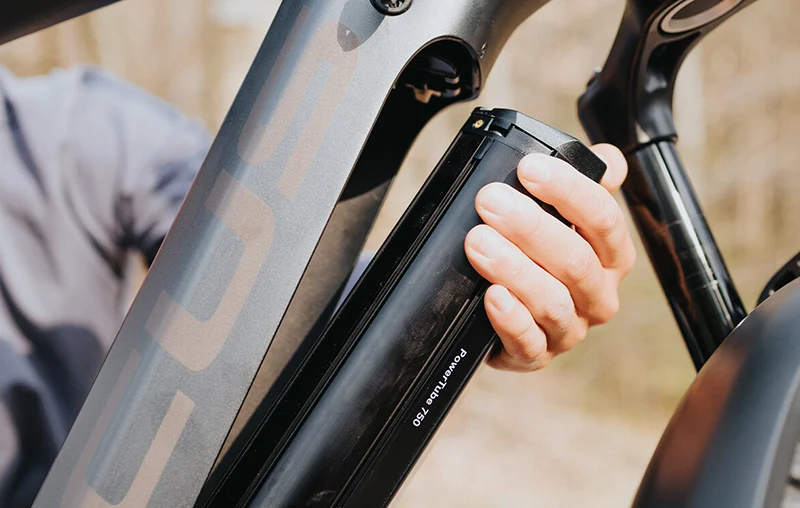
Source: www.bosch-ebike.com
With this guide to e-bike batteries, we hope to empower you with the knowledge to make informed decisions when buying an e-bike and caring for the one you have. Understanding your e-bike’s battery is key to optimizing its performance and lifespan.
As technology continues to advance, we look forward to further innovations in battery technology that will allow us to go farther than ever before.
Related Posts
Dual Battery E-Bike Selection: 7 Best E-Bikes with Two Batteries
Longest Range E-Bikes: Which E-Bikes Can Go Farthest?
How Do Electric Bikes Work? Here’s 14 Things You Need to Know
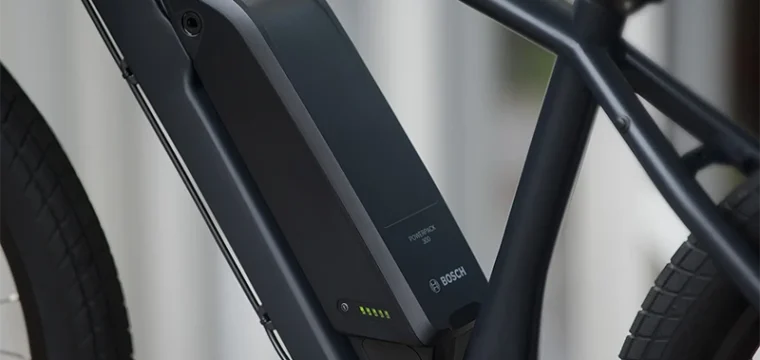
Excellent article. Thank you
You’re welcome! Thank you for reading!